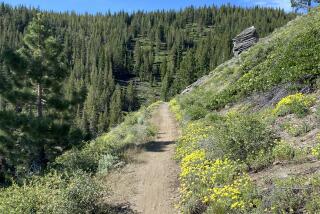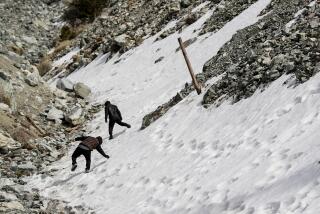Great Read: ‘Trail angels’ help keep Pacific Crest hikers on the path
By any measure, the Pacific Crest Trail is a beastly thing, an angry anaconda that slithers up the entire length of California and all the way to Canada, some 2,650 rugged miles. That’s approximately 6 million steps — some of them glorious, many of them merciless.
But along the way, mercy is at hand.
Near the southern trail head, Sandy and Barney Mann open up their five-bedroom San Diego home to up to 60 hikers a night. They even pick them up from the airport and ferry them and their gear to the starting point an hour east.
Up the trail, in Agua Dulce, Donna and Jeff Saufley not only provide a night’s rest to more than 1,000 hikers a season, they offer food and shelter to their dogs, horses and the occasional llama.
East of the Bay Area, Hank Magnuski functions as a sort of outdoors concierge, erecting a pop-up cafe to provide hot coffee and fresh fruit topped by whipped cream to hikers coming off a particularly grueling 300-mile stretch.
They are all part of a small network of outdoor Samaritans called “trail angels.”
These self-appointed volunteers assist long-distance hikers on one of the most grinding outdoor challenges in the world — comparable, many say, to summiting Mt. Everest. And they do it with little or no compensation, other than the grateful smiles and occasional post-trail postcards.
“There is a quote in Hebrews,” Donna Saufley says. “Something along the lines of, ‘To show hospitality to strangers is to entertain angels.’”
::
Estimated at fewer than 100, the trail angels may be America’s least-known charitable army. They reach into their own pockets to provide, food, shelter, medicine and hot showers to hikers. If you insist on leaving money under your pillow, they’ll usually donate it toward trail maintenance.
Cheryl Strayed’s bestselling hiking memoir, “Wild,” now a Reese Witherspoon movie, touches on their exploits.
“I think people basically want to help, but it’s so complicated — ‘What’s the best way to help a homeless person? Where do I start?’” Strayed says by phone. “With long-distance hikers, the needs are so simple and the payoffs are direct.”
The trail angels explain their generosity by raving about the types of people they encounter. Like Donna Saufley, most consider helping the hikers a spiritual — almost churchly — endeavor, something they were ordained to do.
“We’re our better selves out there,” she says of the hikers she helps.
An angel among angels, Saufley is the best-known of the trail volunteers. She left a corporate career early and now splits her time between helping hikers and tending to the family electrical contracting business.
Beginning in April, she and her husband set up tents and a trailer to handle the spring crush. Their home, dubbed “Hiker Heaven,” is a popular mail drop where backpackers — always desperate to lighten the load — can send and receive packages.
But she sees the long-distance hikers unload more than just unnecessary gear. She talks fondly about the payoffs of being a trail angel: witnessing the hikers’ emerging humanity, their grit, their brio and the inevitable baring of souls.
Traveling the trail “is humbling,” she says. “I compare it to the peeling of an onion. You see people for what they are.
“I have to say, far and away, these are some of the most interesting people on the planet,” Saufley says. “I always say that it’s a river of life that washes up to my shore.”
Almost none of the trail angels consider what they do an act of pure charity; rather, they think they get as much from the experience as the hikers themselves.
“I am involved on a selfish level because I want to get to know the hikers,” says Pea Hicks, a San Diego musician who helps hikers get started at the Mexican border.
“It’s a vicarious way to stay involved in the whole thing,” says Hicks, who hiked the trail in 2006.
As with the trail itself, the angels are a blossoming phenomenon.
Saufley says that during her first year — 1997 — she hosted 50 hikers all season. Last year, she often had that many staying per night, with a total of 1,200 for the summer.
She loves it when her sanctuary is filled with hikers.
“The sounds of conversations mingling with music and laughter is divine to my ear,” the 58-year-old says.
::
There’s a Latin phrase, solvitur ambulando (“it is solved by walking”). And each year, the Pacific Crest Trail Assn., which handles permits, says 2,000 or so people try to solve their lives — or merely accumulate stories of river crossings and bear encounters.
Most of the permit carriers are hiking significant stretches of the trail, with about 1,000 attempting the entire length. Only about half complete the whole thing, the association and others say.
Total thru-hikers are up 15% to 25% a year, though, and the trail has become California’s newfound mighty river, drawing enthusiasts from as far away as Australia. As with rivers, it is unable to make up its mind. Around one S curve, a rock slide; around the next, a fallen ancient cedar, big as a bus.
Then there are those endless granite staircases. In the Sierra alone, there are nine passes of 10,000 feet or more.
Some hikers complete the trail several times. Trail angels Barney and Sandy Mann did the five-month march seven years ago to celebrate 30 years of marriage. Two years ago, Ron Ulrich, a Portland man with an affinity for wedding dresses, hiked the whole thing in 26 used bridal gowns. Solvitur ambulando....
“For some, it’s a religious pilgrimage,” Saufley says. “For others, it’s a pub crawl.”
Facing their 10th year of taking in hikers, the Manns say those they’ve helped often stay in touch with post-trail notes and cards. Almost through word of mouth alone, they have become a go-to resource:
“We get the strangest emails — ‘I’ve never written to a total stranger before asking to stay at their house, but I’m told it’s OK,’” Sandy says.
And though the trail angels all claim they’re really in it for themselves, there is still something ... well, faintly divine about their dedication.
Barney, a retired lawyer, confesses that providing airport runs and meals to hundreds of strangers each spring can leave him and Sandy tired and spent. So what.
“During that time, we go to bed exhausted, and we will invariably turn to each other and say, ‘We are so lucky to be able to do this.’”
“We do it because we can,” adds Sandy, a retired biology teacher.
For Saufley, the transformations she sees in people are a fair trade for the expense and fatigue.
“They go out for the nature,” she says of her long-distance guests. “And they end up finding the peace within themselves.”
Solvitur ambulando.
Twitter: @erskinetimes
More to Read
Get our high school sports newsletter
Prep Rally is devoted to the SoCal high school sports experience, bringing you scores, stories and a behind-the-scenes look at what makes prep sports so popular.
You may occasionally receive promotional content from the Los Angeles Times.







